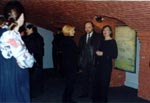Abstraction in Russia. XXIst Century. Modern Technologies.
 Catalogue. In term of the State Russian Museum’s project Abstraction in the Russian Art. XXth century. Sergeyev Sergey (St. Petersburg) Computer painting. Sergey Shutov (Moscow) Videofeedback. Traditional ways of creating works of art have been supplemented in the twenty-first century by such modern media as digital, computer and electronic technologies. Two outstanding examples of the use of modern technologies to create abstract art are the works of Sergey Sergeyev and Sergey Shutov, exhibited as part of the Russian Museum’s “Abstraction in Russia: ХХ Century” project. Sergey Sergeyev’s computer painting addresses the psychology of the palimpsest. A palimpsest is a structure containing an erased (forgotten or displaced) text or image beneath another text, countenance or image, sometimes with the previous content, though generally with a new one. In somewhat broader terms, our memories and culture have the structure of a palimpsest (stratification). The palimpsest principle covers any semiotic system based on universal images. From the unconscious, Sergey Sergeyev recreates “lenses” that are, in essence, engrams – structures recording memories. While the artist employs computers in his work, his images are created manually. The sequence of the processes concurs and the artistic text is written from nought. All Sergeyev’s images are hand-made; the only thing that changes is the instrument. Sergey Shutov’s videofeedback abstract images are related to the methodics of constructing space, the self-organisation of colour and composition and the meditative demonstration of the life of physical processes and the interrelations of electrons – abstract from anthropocentric positions and profoundly logical from the point of view of heroes of display, light and time and the unity of the oppositions of chaos and cosmos. Videofeedback occurs when filming a monitor with a video camera. The video camera picks up the light from the monitor and instantly returns this signal to the monitor. The slight time delay changes the video image, producing a sustained video-echo. With the camera correctly trained on the monitor, the result is a mirror-like optical effect. The video camera can be used to influence the video image, regulating such parameters as size, focus and diaphragm (iris). Regulating the colour and brightness controls also influences the video image. Objects can be placed between the camera and the monitor display. A videofeedback is a non-linear, two-dimensional model with a high speed of cyclic doubling. Such disciplines as fractal geometry, chaos theory, bifurcation and questions of time all investigate videofeedback as a non-linear and self-organising formation of structure.
Catalogue. In term of the State Russian Museum’s project Abstraction in the Russian Art. XXth century. Sergeyev Sergey (St. Petersburg) Computer painting. Sergey Shutov (Moscow) Videofeedback. Traditional ways of creating works of art have been supplemented in the twenty-first century by such modern media as digital, computer and electronic technologies. Two outstanding examples of the use of modern technologies to create abstract art are the works of Sergey Sergeyev and Sergey Shutov, exhibited as part of the Russian Museum’s “Abstraction in Russia: ХХ Century” project. Sergey Sergeyev’s computer painting addresses the psychology of the palimpsest. A palimpsest is a structure containing an erased (forgotten or displaced) text or image beneath another text, countenance or image, sometimes with the previous content, though generally with a new one. In somewhat broader terms, our memories and culture have the structure of a palimpsest (stratification). The palimpsest principle covers any semiotic system based on universal images. From the unconscious, Sergey Sergeyev recreates “lenses” that are, in essence, engrams – structures recording memories. While the artist employs computers in his work, his images are created manually. The sequence of the processes concurs and the artistic text is written from nought. All Sergeyev’s images are hand-made; the only thing that changes is the instrument. Sergey Shutov’s videofeedback abstract images are related to the methodics of constructing space, the self-organisation of colour and composition and the meditative demonstration of the life of physical processes and the interrelations of electrons – abstract from anthropocentric positions and profoundly logical from the point of view of heroes of display, light and time and the unity of the oppositions of chaos and cosmos. Videofeedback occurs when filming a monitor with a video camera. The video camera picks up the light from the monitor and instantly returns this signal to the monitor. The slight time delay changes the video image, producing a sustained video-echo. With the camera correctly trained on the monitor, the result is a mirror-like optical effect. The video camera can be used to influence the video image, regulating such parameters as size, focus and diaphragm (iris). Regulating the colour and brightness controls also influences the video image. Objects can be placed between the camera and the monitor display. A videofeedback is a non-linear, two-dimensional model with a high speed of cyclic doubling. Such disciplines as fractal geometry, chaos theory, bifurcation and questions of time all investigate videofeedback as a non-linear and self-organising formation of structure.